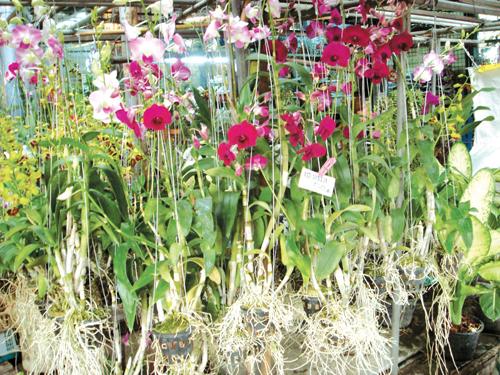Phuket Gardening: Nursery education

PHUKET: With the wet season looming, now is a good time to put the spotlight on Phuket’s plant nurseries, or what North Americans refer to as garden centers. After all, we will doubtless be paying them a visit or two in the near future, so let’s suspend our A to Z of plants for a moment.
First the good points: Phuket has a large number of these nurseries, many dotted along the main roads such as Chao Fa East and West that link the old town to the southern littoral of the island. Secondly, these centers have a good range of plants, usually sensibly arranged according to species. There are the inevitable colorful annuals such as African marigolds or globe amaranths, perennials such as the fashionable lavender colored ruellia,and of course ever-popular shrubs such as potted multi-hued bougainvilleas, wrightia, jasmines, plumerias and hibiscus.
Under the green or black awnings one will usually find a range of shade-loving plants; including foliage plants such as algaonema, dieffenbachias, philodendrons, anthuriums and neoregelias. Right now many nurseries are decorated with hanging pots of colorful busy lizzies, white mandevillas, portulacas and even petunias. The customer service is invariably friendly and basic information about a plant’s requirements is usually forthcoming – on request. Moreover, the plants on display are normally healthy and well-cared for.
I do however, confess to having some reservations about Phuket’s nurseries. Sometimes the proprietor is not there and has left the place to one or more immigrant assistants who can’t sell you anything anyway. A wasted journey.
More importantly, there is in my experience, little or no systematic labeling of plants and still less in the way of written cultural information. Alright, if we have any sense we go on our purchasing missions armed with books containing photographs and even Thai names. But more, much more, could be done to help the would-be buyer. Even basic stuff on plastic notices attached to the relevant group of plants would help; whether they are acid or alkaline loving; whether they prefer a position in full sun, or semi-shade; how often they need fertilizer; what size they can be expected to achieve and so on.
Pricing is, in my humble opinion, on the high side. After all, plants grow all the time and what sells at 25 baht in a small five inch pot becomes, in a matter of weeks, a 50 baht specimen in a larger container. Expect to pay 150 baht for a shrub in a ten or twelve inch pot.
It is also difficult to bargain or to negotiate a discount when buying a number of plants. I know of only one nursery woman who consistently drops her prices for bulk buying on request and her prices are mostly lower than average already.
Also, why be so secretive about prices? A nursery on Chao Fa West, now long since gone, used to have massive signs advertising its wares; its small plants were variously priced at five, seven and ten baht. Of course, it did a roaring trade.
Few nurseries sell fertilizer and even fewer sell specialist food with different amounts of nitrogen, phosphate and potassium. Fewer still sell packeted seed and even more surprisingly, trees. Admittedly most centers do sell white bags of compost and many have piles of coconut fiber, which is useful for mixing with top soil or employing as a mulch. Top soil however, is very difficult to obtain. You might do better to seek out a new building site and ask the back-hoe operator to dump a load in your truck. It has been done.
Two final points. Old established nurseries are often better than the new kids on the block. They are far more likely to have mature, well established shrubs for sale and probably at a better price. They may well have a business arrangement with resorts or hotels which means that mark-ups are likely to be less punitive.
Be careful not to buy plants that are too pot-bound or that may have thrust a long tap-root into the soil below the container. Most likely it will be chopped off when the plant is sold. On the other hand, bushy roots that have spread through the holes below the base of the pot indicate healthy growth. Just use great care when removing the plant. It is all too easy to damage the fragile root system, so cut away the entangled plastic and gently ease the root from its container.
Tip of the week – Pampering your palms
PALMS are low-maintenance – ideal for the gardener who doesn’t want to get his hands dirty. Once established, most will require little attention. But old fronds do start to go yellow or brown and finally die. When this happens they look scruffy and unsightly because they tend to stay limply attached to the tree.
With some varieties there is a simple solution. With yellow cane (dypsis lutescens) or sealing wax palms (cyrtostachys renda), just pull sharply on the yellowing frond and it should come away from the trunk, together with the sheath..
In the case of other palms, you will need to cut off the old part close to the trunk with a sharp knife or hatchet: for example with palmyras (borassus), coconuts (cocos nucifera), foxtails (wodyetia) or travelers palms (ravanala). Sometimes it is necessary to remove lower fronds to improve the shape of the tree – as with the blue-gray bismarck palm (bismarckia).
If you have a question or a garden that you would like featured, you can email the author here.
Keep checking our online Phuket Lifestyle pages or join our Facebook fan page for regular gardening features and tips.
This article appears in the current (May 4-10, 2013) issue of the hard-copy Phuket Gazette newspaper, now on sale at newsstands throughout the island. Digital subscribers may download the full newspaper, this week and every week, by clicking here.
— Patrick Campbell
Latest Thailand News
Follow The Thaiger on Google News:


























